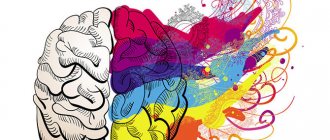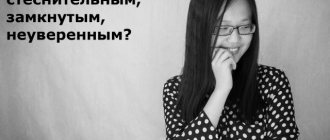Often in childhood we hear such phrases: “How inattentive you are!”, “You always ignore everything!”, “You don’t remember anything, like old people,” and something like that.
And due to their young age, for many these phrases sound like a sentence. A person forever remembers that he is incapable of concentrating on anything, that such professions as a machinist, pilot, intelligence officer, surgeon or even programmer do not shine in his life. Because of this, such a teenager’s subconscious choice may fall on the humanities, even if he has good abilities in natural science, technical and mathematical disciplines. This is how one categorical remark from a parent or teacher can affect the fate of a child or student as a whole.
After all, the child does not understand that attentiveness is something that can be developed in oneself, and the situation, often momentary, can be turned in one’s favor. A negative assessment from an adult can only concern a specific moment, but the unquestioned authority of an elder can elevate it to an absolute. The little man has nothing to oppose, he does not yet have the opportunity to refute comments with reason, and sometimes he is not allowed.
But something needs to be done about it, and before you give up on your career because you “have had sclerosis since childhood,” you can turn the situation in the right direction. But first you need to understand whether the concept of mindfulness is static when applied to a specific person and whether it will really be possible to develop it?
What is attention in psychology?
Before asking questions about how to increase attentiveness and improve concentration, you should define what attention is?
A brief definition of what mindfulness is in psychology is as follows: attention is the preferred or selective orientation of perception, which subordinates all senses to this process.
It’s not for nothing that in Latin attention literally means “reaching out for something.”
In addition, the following speech patterns indicate the relationship between attention and a person’s active action: pay (literally turn) attention, direct attention, attract attention.
In order to learn how to manage your attention, you need to know its properties and features, and in fact, understand the physiology of attention itself.
Multitasking is a myth
Popular publications write that it is supposedly possible to increase work efficiency and improve attentiveness by practicing multitasking. However, according to research, multitasking is a skill that, firstly, is impossible to develop, and secondly, it is completely unnecessary.
According to the work of neuropsychologist and professor at the University of Utah David Strayer, multitasking is a unique ability: no more than 2.5% of people have it. It is determined genetically and developing it is a waste of time. “We deceive ourselves and tend to overestimate our ability to multitask,” the scientist is convinced.
Experiments conducted at Stanford University showed that subjects tasked with solving multiple problems at once performed worse on the tasks. Multitasking may seem effective at first, but it ends up taking up to 40% more time and producing error-filled results, according to the American Psychological Association.
Attention, physiology and properties
In fact, the main property of human attention is its mobility. In other words, our attention fluctuates all the time.
At some point, it may cover many subjects at the same time. Then quickly weaken and suddenly move towards some other object.
Human attention is like a spotlight with a constantly changing focus. Sometimes a narrow but powerful band of light shines, sometimes it shines wide but weak. This attention spotlight is also capable of instantly rotating on the tower. Remember the expression: pay (deploy) attention?
In fact, the mobility of the ray of attention allows a person to notice potential dangers and avoid many troubles. But for productive work, especially mental work, we need to literally fix our attention on one object. Figuratively speaking, concentrate the beam, and for a long time.
That is, a person’s task is to learn to control this obstinate and unpredictable spotlight of attention.
So, here we understand that the ray of attention cannot be stopped? So what should we do now? How to increase attentiveness?
So, a person’s attention is in constant motion. At the same time, the ray of attention is able to follow one or another movement.
Therefore, we are required to select the movement that we will follow. Essentially, it is the route or path of attention we need at the moment. And then (stretch) try not to leave it, maintaining attention.
TL;DR
- The effectiveness of multitasking is a myth. Remember that only 2.5% of people are truly “multitasking”. This ability is determined genetically and is almost impossible to develop. For others, multitasking is a waste of time and errors in work.
- You might like to meditate; it's a really good way to learn how to pay attention. True, you will need to practice meditation constantly.
- If you can’t concentrate, don’t mock your own brain. He must rest. Take breaks, but use them wisely: light exercise, a cup of coffee, or solving a simple daily problem will help you get back to studying and regain your focus more effectively.
What else do we have on Habré:
- “The educational process in IT”: technological competitions and events at ITMO University
- Startups from ITMO University accelerator - projects in the field of computer vision
Attention when reading
Consider our attention when reading. So, we sat down to read some novel. What kind of traffic is there? Of course, the adventures of the main characters, changing plot scenes, a string of destinies and incidents. You've probably noticed that various action-packed works and films quickly “capture” attention.
What if the book is more serious? For example, “War and Peace” by Leo Tolstoy or another work of classical literature? In books of this kind, not every one of us will see a movement worthy of our attention. But it’s there too! Of course, in such a book there are poignant moments, a cycle of events, but they are much less common here. And behind the long and, at first glance, boring descriptions of the appearance of the main characters, not everyone will notice the dynamics of the image of this or that character, the movement of his inner world, feelings and experiences.
Not everyone will appreciate the dynamics of the pictures of nature that the author of the work draws. As a result, our attention weakens.
Well, what if we need to master technical or scientific work? What then? Did our attention cry? And in most cases this is true! And all because we do not notice or are not able to consider the fascinating movement of the author’s thoughts.
It is for this reason that small children do not like descriptive pictures of nature. They are only able to follow dynamic, fast movement, as in adventure books and films.
But we are not little children, are we? Although few adults have grown from their level in this regard. And few of the younger generation are able to with due attention master more printed text than messages on social networks.
However, the more a person engages in self-development and the higher his culture and self-education, the more different kinds of movements in life he is able to capture! This means focusing your attention on them.
How to become attentive?
Many people have noticed that attentiveness is especially heightened at the moment when we are doing other things at work and at the same time watching the boss’s door. This is one of the simple and effective exercises for training concentration. But there are other simple techniques aimed at improving attentiveness and parallel actions, developing the ability to switch to other processes. By doing them regularly, you will see noticeable results over time.
Surrounding reality
It’s good to practice mindfulness on the way to work or while walking. Instead of immersing yourself in your own thoughts, it is better to pay attention to the people around you, noticing as many different details as possible.
For example, meeting a neighbor. Having said hello as usual, it is worth noting to yourself his name, appearance, a bright or remarkable detail of his clothing. Mentally make up a couple of phrases: “Volodya – a leather jacket, like a colleague’s” or “Larissa – green wedge shoes.” Such entertaining associations will help you quickly remember the name and image of a person.
And while in transport, you need to try to remember advertising signs, outlines of objects, landmarks on the road, terrain features, in a word, anything that will force you to pay attention to the little things. And on the way back you should remember everything that was discussed in the morning.
This method of concentration further develops observation skills. In the future, you will unconsciously begin to catch the nuances that catch your eye and remember more information.
Special entertaining techniques
Mindfulness can be trained in a fun and interesting way. This type of training includes solving puzzles, crosswords and rebuses, assembling puzzles, any board games, and various attentiveness tests. Activities that require concentration improve the ability to concentrate significantly.
The simplest game is “Find the Differences”. Through vision, 90% of information is absorbed, therefore, through visual perception, concentration, observation and memory are gradually trained. In the future, a person will learn to quickly assess the situation and make a worthy decision.
Other options for training mindfulness using pictures:
- games related to searching for more homogeneous objects in a picture;
- images that allow you to view a picture using 3D technology from a certain angle;
- drawn labyrinths through which you need to find your way to an object or exit;
- searching for numbers or objects in encrypted geometric shapes, etc.
You can also practice mindfulness in the company of friends, for example, by playing the game “What Has Changed.” It asks one participant to leave the room while the others exchange accessories or items of clothing. Then the player who returns to the room is asked to determine who is wearing other people’s things. Another option is to take the whole company to an quest room, where you will have to demonstrate your intellectual abilities, attention, and speed of reaction.
We don't switch
Psychologists note that concentration of attention during the work process is constantly scattered. This especially happens against the backdrop of accompanying events: the aroma of coffee, after which you want to get up and make a cup of coffee, or a bouquet that attracts you with a wonderful smell, or a group of colleagues discussing going to the movies. We get distracted, but through an effort of will we return to current affairs and notice that we cannot get back on track and make mistakes.
It is possible to control such switching moments. First, let's do a simple exercise . To perform it, you need to turn on the TV and find an exciting program. For two minutes you should look at the clock with the second hand and not be distracted by the TV screen. After the time has passed, retell what was discussed in the program. If you can’t remember anything, it means that at this stage to develop attentiveness.
Another method involves control in writing of all switching moments. Throughout the day we keep notes in a notebook, and before leaving home we count them. At the same time, as soon as you need to make a recording, we mentally ask ourselves the question: “Do I really want to do this or think about it?” Such actions allow you to control moments of distraction. As a result, the total time spent on extraneous actions or thoughts can range from several minutes to hours. For many, this method will make them value their own time more and not waste it on trifles.
Scientists have proven that the more you practice strengthening concentration and focus, the more they take root at the subconscious level. Be attentive to the little things , try to keep two or even three actions under control, do not be distracted from the main thoughts, play useful games. An integrated approach will help you achieve the desired results much faster.
Mindfulness and listening to music
For example, have you noticed how some adults listen carefully to music. They sit without moving and follow the movement of the composer’s feelings and thoughts, trying to recognize his intention. At the same time, those who do not understand music cannot notice any movement there.
He is not able to listen carefully to a piece of music because it seems boring and monotonous to him. As a result, such a person’s attention switches to something else or to thoughts about himself. Thus, his ear “stops” hearing and his eyes “stop” seeing. Of course, he can try to catch himself, but it won't last long. A few more seconds pass and his attention wanders again.
Consequently, when a person is not developed, he is limited in the perception of various aspects of life. He can only notice external movements: chases, jumps, adventures.
On the other hand, the ability to learn and increase our knowledge of the world around us greatly enhances our ability to distinguish many subtle movements.
So, in order to improve mindfulness, we need to understand the most important thing. Namely, that attention is always tracking some kind of movement.
At the same time, self-development and self-education opens up opportunities to notice hidden movements in nature, art, science and people. Which, in turn, significantly increases our ability to concentrate attention on a particular subject.
Exercises to improve concentration
Scientists have paid attention to one phenomenon: the best achievements in mathematics, writing and reading are observed in children who learn to play musical instruments in parallel with their school studies. What's the catch here? After all, a child’s mind is even more loaded if he learns music in addition to the usual elementary school disciplines. When playing an instrument, a person usually uses two hands. On plucked or bowed string instruments, the left hand clamps the frets on the fingerboard, while the right hand actually vibrates the strings - with the fingers, a pick or a bow. But at the same time, the hands act harmoniously. The hemispheres of the brain also work harmoniously.
If your plans do not include mastering any musical instrument (and not only strings are suitable, but wind instruments, percussion instruments, etc.), then you can try drawing different figures with both hands at the same time. You can train your left hand (if you are right-handed) separately ahead of time if you cannot portray anything with it at all. Now start drawing circles with one hand, and angular shapes with the other: triangles, squares, rhombuses. Do both at the same time.
Along the way, when you walk your usual route, you can also train your concentration. You meet a neighbor, remember his name, pay attention to his clothes, note some remarkable object in it, for example, a colorful tie or a new handbag. Now mentally make up pairs of words: “Ivan Valerievich - a tie like Lenin’s” or “Praskovya Petrovna - a handbag made of crocodile skin.” Such cheerful associations will help you remember both the person’s name and his image.
If you have a good auditory memory, then read out loud the phone numbers of your friends from your address book. Do this with your eyes closed. You will see that it is easy for you to remember information that you previously obtained exclusively from a notebook. With good visual memory, you can come up with interesting images for numbers or choose a different color for each of them. Now try to remember the numbers written in the notebook. This way you will train both memory and attentiveness.
Helpful advice on how to improve your mindfulness
In order to increase your perception and attention, I recommend starting to read the Bible. Since it contains all kinds of movements from obvious (the book of Genesis, Esther, Nehemiah, the Gospel of Mark), to little noticeable (the book of Proverbs, Exodus, Psalms, Matthew, Luke), barely discernible (Ecclesiastes, Job, Song of Songs) and even hidden ones (the book of Daniel, Revelation, the prophet Ezekiel, Leviticus).
The Bible is an excellent tool for training our attention. Since there are both movements that are difficult to perceive, and the simplest ones.
Outstanding writers, artists and scientists knew about the Bible firsthand. In my opinion, every self-respecting person should study this book of amazing relationships and movements.
Verbal attention
It is not so easy to focus on the speech we are listening to.
Verbal attention also depends on how skillfully we follow the dynamics of the speaker’s thoughts.
And for this it is extremely important to grasp the meaning of his words. Since the words themselves are monotonous and there is no movement in them. The movement itself lies in the direction of thought.
Let’s say that if we are not familiar with a certain language, we will not be able to listen carefully to incomprehensible speech in it even for ten minutes. Therefore, it is important to keep the speaker’s thoughts “in the beam” at all times.
Types of attention and ways to increase attentiveness
Here are some ways to improve your mindfulness:
- First, body position, posture, and even facial expression influence our attentiveness. Attention sharpens when a person is motionless, collected, and serious. Watch a person who is all attention. He has completely different facial expressions and facial expressions: he is serious, his eyebrows are knitted, some of his facial muscles are tense.
- Secondly, in order to concentrate, we must internally convince ourselves that we really really need it
- Thirdly, in order not to lose attention, we need to think only about what we are reading or what we are being told. In other words, ask yourself questions on the topic and internally look for answers to them. Follow the movement of the author’s thoughts and get carried away by this movement (which was described in detail above).
As you know, the main types of attention are voluntary and involuntary attention.
The first three techniques relate to voluntary and volitional attention (the first type of attention). This is the necessary preparation for “working in” to happen. This period is characterized by incomplete or weakened attention. But some time passed, and we didn’t notice how carried away we were.
Now comes the phase of involuntary attention. This is the second type of attention. This attention now works on its own. But it arose as a result of our efforts to fulfill three main points.
Also, it should be emphasized that interest in work and the feeling of its necessity increases our concentration. And passion for work allows us to maintain our attention on it for a long time. Meanwhile, a drop in attention is the first sign of fatigue.
Thus, passion and attention are closely related to each other.
Attention is “the nerve of every psychological system”
General psychology defines attention as a person’s ability to concentrate at a certain point in time on any object: an object, event, image or reasoning.
Attention can be voluntary - dependent on conscious interest, and involuntary or instinctive (you will notice a conventional clap of thunder, regardless of your desire). Need is another important factor influencing attention: a hungry person walking around the city will look at restaurants and cafes more often than a well-fed person. The most important characteristics of attention are its selectivity and volume. So at an event, a person first hears only the general noise of voices. However, as soon as his acquaintance suddenly speaks next to him, the attention of one and the other person will switch to their voices and communication. This phenomenon, known as the “cocktail party effect,” was experimentally confirmed in 1953 by Edward Colin Cherry of Imperial College, University of London.
The amount of attention can be expressed in the number of objects on which a person is able to concentrate at a certain moment. For an adult, this is approximately four to five, maximum six, unrelated objects: for example, letters or numbers. This does not mean that we simultaneously perceive only a few words in the text - these can also be semantic fragments of the material. But their number is no more than six.
Finally, attention is characterized by its ability to move from one task to another (absent-mindedness from this point of view is an insufficient ability to do this effectively) and stability - the ability to maintain concentration for some time. This property depends on the characteristics of the material being studied and the person himself.
Photo: Stefan Cosma / Unsplash
Focusing attention is one of the conditions for successful work and study. Charles Darwin wrote in his autobiography, Reminiscences of the Development of My Mind and Character, that his work was helped not only by “the habit of energetic work, but also by attention to any task in which he was occupied.” And the Anglo-American psychologist Edward Bradford Titchener in his book “Lectures on the Experimental Psychology of Sensation and Attention” (1908) called it “the nerve of every psychological system.”
The ability to concentrate has a positive effect on academic performance. This is evidenced by MIT research conducted in Boston. They talk about attention as “a form of mental activity that you need to be able to maintain.”











